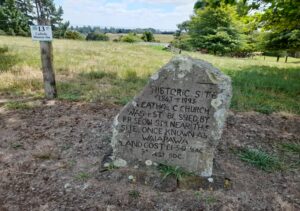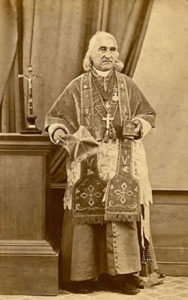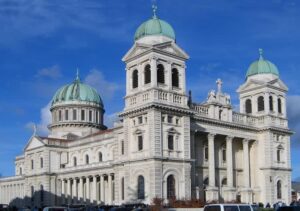1843: Waiapawa Mission
March 12, 2023
By AHNZ

Take a drive along Old Te Aroha Road in eastern Waikato and you can observe a large lichen-encrusted crag of un-improved proto-masonry pointing up to heaven. Those inclined to investigate history will slam on the anchors and back up the car for a second look, much to the eye-rolling of their wives/husband/girlfriends/boyfriends who generally would prefer to have kept on going. Etched in big block capital letter into the stone somebody has stated the following…
HISTORIC SITE
A CATHOLIC CHURCH WAS ESTABLISHED BY FRIER ANTOINE JOESPH SEON (SOCIETY OF MARY) NEAR THIS SITE, ONCE KNOWN AS WAIAPAWA
HISTORICAL SOCIETY
(for exact words see image, left)
On a fence post behind, thanks to Matamata Piako District Council, there’s marker #13 of their Heritage Trail.
Father Seon opened a Catholic Mission Station here (1841-1844) at the instigation of Jean-Baptiste Pompallier, Vicar Apostolic of Western Oceania, Catholic authority over one-sixth of the planet Earth. Ref. Bishop Jean Baptiste Pompallier, AHNZ
Missionaries had tried fishing for Maori souls in these parts before but it ended disastrously for the Anglicans at Matamata who had to flee for their lives in 1836. A young Maori girl, one of the Mission children, was killed in the process but by her death spread Christianity in the long run. Ref. 1836: Tarore Immortalised, AHNZ
 Father Seon’s (1806-1878) first job in New Zealand was to proceed to Waiapawa to establish 2 churches¹ in the Waikato including this one at Waiapawa. According to the Council Guide, “On 20 February 1843, a half acre of land at Okauia was purchased from the Maori owners for £1-5-0 (one pound five shillings) and Father Seon transferred to a church built here. It was used by Catholic travelers as a stopping place between Tauranga and Te Awamutu.” Willoughby Shortland was acting as Governor during this time and perhaps Article 2 of the Treaty of Waitangi was not being observed or else the Catholics would not have been able to buy land from Maoris directly this way.
Father Seon’s (1806-1878) first job in New Zealand was to proceed to Waiapawa to establish 2 churches¹ in the Waikato including this one at Waiapawa. According to the Council Guide, “On 20 February 1843, a half acre of land at Okauia was purchased from the Maori owners for £1-5-0 (one pound five shillings) and Father Seon transferred to a church built here. It was used by Catholic travelers as a stopping place between Tauranga and Te Awamutu.” Willoughby Shortland was acting as Governor during this time and perhaps Article 2 of the Treaty of Waitangi was not being observed or else the Catholics would not have been able to buy land from Maoris directly this way.
It seems these Okauia Maoris knew the site of this church as Waiapawa at this time but that name is now lost to time apart from this stone marking the old locality. One thing we might know is that those who stayed at the Waiapawa Mission would have known about and visited the nearby Wairere Falls which are still an attraction today.
Seon had come to Pompallier at the capital city of New Zealand, Russell, with a fresh intake of other Catholic men in June 1841. By the end of the following month Bishop Pompallier (image, right) took them on the road to get to work setting up Missions. Or, rather, to sea on the Mission schooner Sancta Maria. Seon was deployed to Matamata where, according to the Council Guide, the church he established at Waiapawa endured from 1843 to 1857. It sounds from the Guide that the church did not make Catholic headway into the souls of the Maoris so much as it was a stop-over venue for existing Catholics passing through.
“In June there arrived Fathers Seon, S.M.,…At end of July, the Sancta Maria, with the Bishop, five priests, several catechists, visiting chiefs and natives, sailed from the Bay of Islands. Auckland, Coromandel, Maketu, Opotiki, Matamata and Rotorua were all visited in turn. A meeting of Catholics in Auckland, presided over by the Bishop, decided to build church and priest’s residence on site granted by Governor Hobson. Father Seon left at Matamata,…” – History of the Catholic Church in New Zealand, Catholic Schools Journal March-April 1937; Faith Central.org.nz
“After six weeks Father Seon was sent amongst the Maori tribes at Mata Mata, Waikato, East and West Coasts, &c., where through his exertions two churches were erected, which unfortunately were destroyed during the late war. ” – DEATH OF FATHER SEON, Hawkes Bay Herald, New Zealand Tablet (1878,) Papers Past
Waiapawa Church, whatever it was called, seems to have been given up on after 1857 then. We are cheated of any historical buildings because the Waikato War about 6 years later saw them both burn to the ground. The stone, then, remembers about 15 years of Mission work about which little seems to be known.
Seon’s Future Career

Joesph Seon’s next assignment was in 1847 at the first of four Royal New Zealand Fencible settlements : Onehunga² (est. 1847.) It’s a safe bet there were many Irish families in this group and, so, Irish Catholics for Seon to attend to. In July 1848 Seon was giving lessons to the Fencible kids at what would become St Joseph’s school, Onehunga.
Now in his early to mid 40s, the French-New Zealander was next assigned to a very logical place for a Frenchman to go: Akaroa. The French colony in Canterbury certainly would have appreciated a Catholic and a Frenchman to minister over them. There is a notebook in the archives for these years that Seon kept of his experiences here⁴.
Seon also expanded his work over the Port Hills where he was the first Catholic parish priest in Christchurch and “first” Maori Missioner in the Christchurch area³ so he must have journeyed beyond the Waimakariri to Tuahiwi and given James Stack some competition.
In 1860 Father Seon re-located to Tuam Street in Christchurch. Apparently the Canterbury Association/Canterbury Provincial Council had allocated land for a Catholic Reserve from the beginning in 1850 but it expired in 1860. When Seon and the Catholics got wind of this they had only 14 days to claim the land by occupying it “for religious purposes.” On the 14th day they had a prefabricated hut erected but situated on swampy ground for years to come until Christchurch was properly drained. This story may be untrue according to the Allom thesis. However, that same land remained the Catholic plot and eventual home of the Cathedral of the Blessed Sacrament (image, left) (1905-2011) down Barbadoes Street opposite the former Christchurch Polytechnic.
In March 1861 Father Seon was recalled to Wellington.
“After the first group of Fencibles arrived, they held the first church services in Onehunga on Sunday 21 November 1847. There was an Anglican service in the morning and a Catholic one in the afternoon. ” – Onehunga Heritage Trail
“In July 1848 a school room was built. Father Seon from the Catholic Church taught the classes. This was the beginning of what is now St. Joseph’s School, Onehunga.” – Onehunga Heritage Trail
“Father Seon was appointed permanently to the South Island some time before 1850 and divided his services between the Catholics of Banks Peninsula and the few at Lyttelton and Christchurch. Father Seon travelled this distance on foot, knapsack on his back, his stick and his rosary in his hand and most of the time alone.” – Allom (1968)
time alone, “
Joesph Seon, being a priest, didn’t get to have a wife or reproduce. Instead of breeding vertically he reproduced horizontally by spreading his values and culture to the people of New Zealand. There is no single biography I can find but the above is an assembly of various mentions of his life. Did the soldiers like him? Did the children? Did the Maoris? Did the French colonists? Did the people of Christchurch? He surely must have been a good Missionary because he was assigned important and challenging jobs and kept being given them for a long career. Eventually, in his late 60s, old age caught up with Seon and he was retired to Meanee Mission Station where he died. His grave is a simple cross with his name on it at Taradale Cemetery.
It’s been an enjoyable journey following this priest through 40 years of service in New Zealand’s history. All because I happened to stop for a better look at that craggy stone poking up at Old Te Aroha Road.
—
1 Ref. Allom thesis, University Canterbury (1968)
2 Ref. Church history in the main related to the Auckland Diocese, Treaty Resource Centre
3 Ref. Special Cathedral Mass, Christchurch Press (1979,) Papers Past
4 Ref. Christchurch Catholic Diocesan Archives, Alexander Turnbull Library
Ref. A. J. Seon, Taradale Cemetery. Findagrave.com
Ref. Matamata Piako District Council Heritage Trail, Joan Stanley (2009;) MPDC.govt.
Image ref. Pompallier; Pompallier Hokianga Trust
Image ref. Christchurch Catholic Cathedral, Greg O’Beirne, Wiki (2005)
2 thoughts on "1843: Waiapawa Mission"
Leave a Reply
 Like Comment Share
Like Comment Share






Brilliant stuff, thoroughly enjoyed your hours of research.
Thanks. Might buy me some points at the Gates if the Catholics turn out to be right.